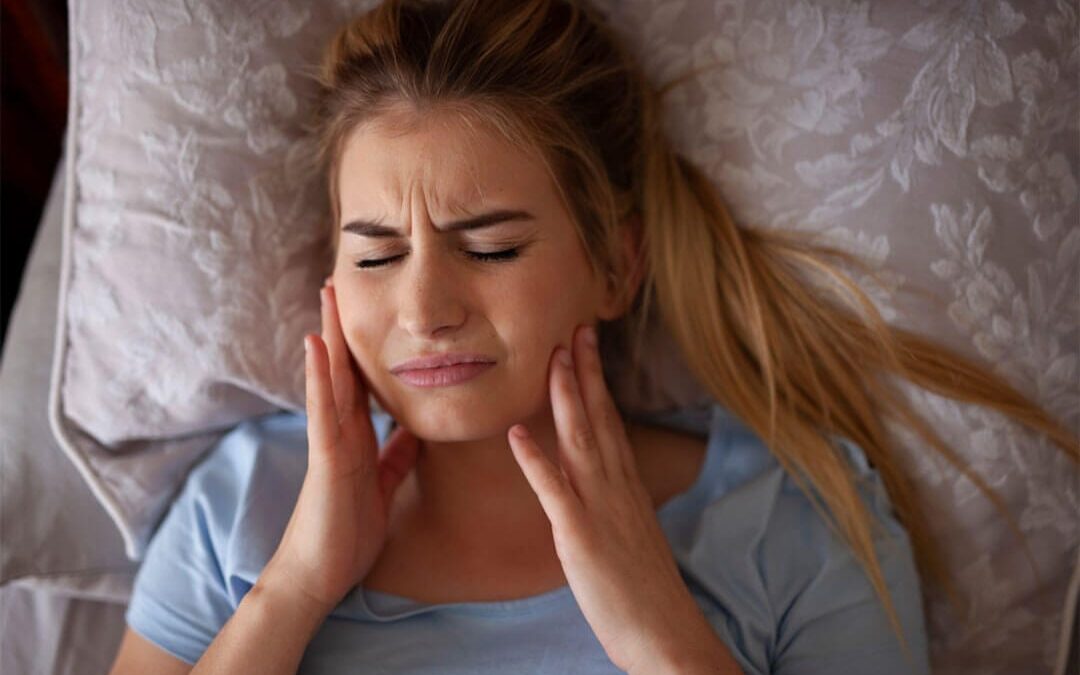Stress of all sorts may cause many of you to grind your teeth just thinking about what you had to do. Did you know that about twenty percent of Americans grind their teeth? That is according to a December 2020 article in “Sporting Smiles.” The author of the article is Dr. Tom McCarthy who said that somewhere between eight to thirty percent of people actually grind their teeth. He said that the average is about twenty percent. You can check out the article at: https://www.sportingsmiles.com/blog/20-percent-of-americans-grind-their-teeth-do-you/
If you do grind your teeth, you know how it can cause headaches, jaw joint pain, and damage to your teeth. Some of you may wear bite guards to prevent further damage. However, the headaches may persist. In today’s newsletter, I will discuss the causes of grinding your teeth, guards to protect your teeth, and then how to slow and even stop the grinding.
What Causes Grinding?
Stress is usually the culprit for grinding, and chronic stress can lead to chronic grinding. Ironically, you may not think you are dealing with stress as most people think of stress as the person sitting behind a desk, biting their nails, and sweating their life. However, causes of chronic stress can be as simple as just getting to appointments, getting your chores done, or just planning dinner. Anything that requires you to focus on it for long periods of time can create stress in your body. Too many times we are so afraid to fail at anything we do that we worry about messing up. The stress comes about because you focus more on not failing than actually doing the thing that’s causing your stress.
Most people grind their teeth at night because their brain does not turn off while sleeping. Not only can this bother your sleep, it may also bother your partner’s sleep. Not being able to turn off your brain is the number one thing I see that prevents most clients from releasing the tension in their muscles. So, what is happening with the muscles of the face?
Every person has a muscle that runs from the lower jaw bone up to the cheek bone and it is named. “Masseter muscle.” Gripping your jaws tightly, forces this muscle to get hard just like a bicep curl makes your bicep hard. Working with the Masseter is another muscle, the Temporalis muscle, that runs from the masseter, under the cheek, and up and around the side of your head. The Temporalis and Masseter work together to hold your jaws tight and grind your teeth. Most of us love to have our Temporalis massaged when we get our hair shampooed. The reason that it feels so good is, we all hold our jaws tightly when we are thinking about something. However, if you grind your teeth, it may be quite painful at first before it lets go.
As the Temporalis and Masseter get tighter, they affect two sets of muscles around the TMJ or Temporal Mandibular Joint. On the inside of the joint is the medial Pterygoid and on the outside is the lateral Pterygoid. When these joints get tight, your jaw may click or even lock up. As you can see, grinding your teeth needs to be addressed as soon as possible.
How to Protect Your Teeth
Today there are several different types of mouthguards to protect our teeth if we grind. Some are hard while others are soft. Your dentist can help you find the best one for you. Most times the dentist may begin with a soft guard and then move to a harder one if the person begins biting through the soft guard. The guard is there to prevent breaking the enamel from your teeth. However, if you bite through it, you may still damage the enamel.
Since stress is the main cause for grinding, some people have turned to meditation and other relaxation techniques, hoping to reduce the stress. For some, meditation can seem too difficult. The idea of sitting for a few minutes and slowing down the thoughts in your head can be too daunting. I would suggest if you want to learn how to meditate, try doing it for only five minutes and then work your way up to twenty minutes.
Other relaxation methods may include breathing exercises, chants, or focusing your thoughts in a specific area. All of these can work well with some practice. It will take some time to get good at it, so be patient with yourself. The problem here is, most people dealing with stress believe they do not have the time because the stress tells them they do not have time. So lack of patience and the feeling of no time, make this a difficult option.
Finding a good therapist who can help you learn to relax your mind would be valuable. There are many techniques that a therapist can show you to slow down your thoughts and give you more control in your life. While I believe in mental therapy, some people see it as a stigma. That fear may prevent them from getting help, which is too bad because the help provided could change your life.
The Best Solution for Grinding
There is a simple way to help reduce the grinding. Each evening before you go to bed, I would suggest these two things to help your sleep better. The first one is the Masseter massage and the second is the Temporalis massage.
The Masseter massage can be done with your thumb, and I would do it with your mouth closed and then opened. The Masseter muscle runs from the cheekbone, the Zygomatic bone, to the lower jawbone, the Mandible. The striation of the muscle runs up and down, so move your thumb across the striations. The thumb will push across the Masseter muscle from the ear towards the mouth. Move downward from the cheek down to the jaw. This may be painful so move gently. Once you go through these steps twice and the pain becomes less, now slide the thumb down the length of the muscle from the cheek, down to the jaw. Make sure to do both sides even if only one side feels tight.
The Temporalis massage is much easier. I use my fingertips when I am massaging my temporalis muscles. Place all four fingertips o the side of your head like you are massaging shampoo into your hair. Move your hand around in circles. Again, this can be painful so begin gently. Be sure to do both sides
Doing these massages each night will reduce the tension in your face from the stress of the day. By doing this, you may find that you sleep better and grind less. It is okay to do these during the day, too, but make sure you do them before you sleep. Below are two more stretches to add to your list which can help you with your neck.
Tips to Improve your Stretching
All you need is a yoga strap and a tennis ball for the tennis ball massage. Give yourself about 15 minutes twice a day and you should see better results within 2 weeks. This, though, is a lifetime event. Think of your pet. they stretch every day and several times a day. Stretch when they stretch. Follow the videos below and free your knees. In my opinion, the calf stretch is the most important stretch a human can do. It will solve many issues of the body.
Stretching is more about feeling the muscles letting go than forcing them to stretch. If you are forcing the muscle, you could be doing strength training, not stretching. Make sure you are feeling the intended muscle stretching. If not, the form could be wrong. Holding for 5 seconds allows the brain to release the muscle before it senses any danger. Repeating the stretches 10 times allows the brain to learn it is safe for the muscle to move that way.
Don’t forget the Tennis Ball Massage!
Softening your hips and back is easy when you use the tennis ball. Just lean against the wall and apply enough pressure to feel the painful area. The temptation is to press harder but resist it. Instead, breathe out and allow the muscle to soften under the ball. Then move to another spot and repeat. Continue doing this until most of the painful spots are gone. Check out previous newsletters to see the video.
If you like this article, please share it with your friends and family. Don’t forget to check out our social media pages, leave a comment, and as always, reviews are awesome!
Subscribe to my YouTube Channel for access to free videos as I post them.
Want to Talk with Me Directly? Start Here
We’re happy to offer you a complimentary 30-min virtual consultation so you can experience this for yourself. Schedule your introduction to Stretch n Release now.
About The Muscle Repair Shop
Drawing upon his personal experience as a former competitive athlete turned wheelchair, obese, and chronic pain sufferer, Muscle Repair Shop Founder Butch Phelps decided to take his health into his own hands when at the age of 36 he was told he might not make it to his 40th birthday. Applying balanced nutrition advice from his doctor along with a sound exercise program, he went from 315 lbs. to 180 lbs. Motivated by his experience, he then acquired degrees in advanced therapeutic massage and aging sciences to help people eliminate chronic pain. This included applying his expertise in how people age, including the effects of dementia, anatomy, psychology, and the day-to-day struggles living as an older person to his practice and development of The Muscle Repair Shop’s one-of-a-kind Stretch n’ Release Technique.
Available through in-office and virtual coaching treatment sessions, this unique combination of stretching and breath work teaches the brain to release the emotional side of muscle tension and pain allows clients to find lasting relief and healing from stiffness, aches, injuries, and chronic pain. The at-home exercises come with customized instructional videos and virtual or in-office support, allowing clients to enjoy and experience life and sports as they did before limitations slowed or curtailed activities.


